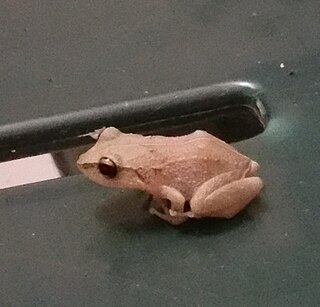
Eleutherodactylus pinchoni is a species of frog in the family Eleutherodactylidae. It is endemic to Guadeloupe and known from the Basse-Terre. Common name Grand Cafe robber frog has been coined for it.

Amolops spinapectoralis is a species of frog in the family Ranidae, the "true frogs". It is at present only known from a few locations in central Vietnam—that is, it is endemic to Vietnam—but it is likely to be found more widely in the Vietnamese Central Highlands as well as in the adjacent southeastern Laos and northeastern Cambodia. The specific name spinapectoralis is derived from Latin spina for "thorn" and pectoralis for "of the breast" and refers to the pectoral spines in adult males. Common name spinyback torrent frog has been coined for it.
The Siamese cascade frog or spotted-snout frog is a species of frogs in the family Ranidae. It is endemic to western and northern Thailand and known from Kanchanaburi, Prachuap Kiri Khan, and Chiang Mai Provinces.
Meristogenys poecilus is a species of frog in the family Ranidae. It is endemic to Borneo and known from between central Sarawak (Malaysia) and central Kalimantan (Indonesia). The specific name poecilus is derived from the Greek poikolos, meaning "pied" or "blotched", in reference to diagnostic pattern on rear of the thigh. Common name Malaysian Borneo frog has been coined for this species.

The Amami tip-nosed frog is a species of frog in the family Ranidae. It is endemic to the Amami Islands, a part of the Ryukyu Islands, Japan. Specifically, it is known from the islands of Amamioshima and Tokunoshima.
Odorrana supranarina is a species of frog in the family Ranidae. It is endemic to Ryukyu Archipelago, Japan, and is known from the islands of Ishigaki and Iriomote, both in the Yaeyama Group. The specific name supranarina refers to the large size of this species —at the time of the species description, it was the largest member of the so-called Rana narina complex. Common name greater tip-nosed frog has been coined for it.
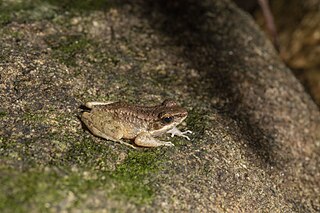
Odorrana utsunomiyaorum is a species of frog in the family Ranidae. It is endemic to Ryukyu Archipelago, Japan, and is known from the islands of Ishigaki and Iriomote, both in the Yaeyama Group. The specific name utsunomiyaorum honours Taeko and Yasuaki Utsunomiya for their contributions to clarifying the amphibian fauna of the Yaeyama Group.

Raorchestes griet is a species of frog in the family Rhacophoridae. It is endemic to the Western Ghats south of the Palghat Gap in Kerala and Tamil Nadu states, India. The specific name griet honours Griet Decock, spouse of Franky Bossuyt, the scientist who described the species. The common name Griet bush frog has been coined for it.
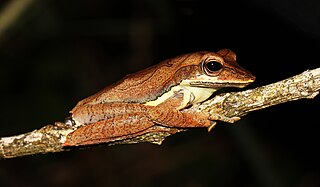
Taruga fastigo is a species of frogs in the family Rhacophoridae. It is endemic to Sri Lanka and only known from its type locality, Morningside Estate near Rakwana. Prior to its description in 2001, it was confused with Polypedates eques.
Rhacophorus exechopygus is a species of frog in the family Rhacophoridae. It is found in the Central Highlands of Vietnam and in the adjacent Annamite Range in Laos. Its range may extend into northeastern Cambodia where suitable habitat should be present. The specific name exechopygus is derived from the Greek words exechos and pygos (=buttocks), referring to the infra-anal projection characteristic of this frog. Its common names are spinybottom tree frog and Tramlap flying tree frog.
Leptomantis rufipes is a species of frog in the family Rhacophoridae. It is endemic to Borneo and known from isolated locations in south-central Sarawak and eastern Sabah and central Kalimantan (Indonesia). Common names Malaysian flying frog and red-legged frog have been coined for this species. The specific name rufipes refers to the red webbing of this frog.

Chalcorana labialis, also known as the white-lipped frog, is a species of "true frog" in the family Ranidae. As currently known, it is endemic to Peninsular Malaysia, although it might also occur in Singapore. Molecular data suggest presence of three distinct lineages in the same area, one of which is not closely related to Chalcorana labialis and which could represent an unnamed species.
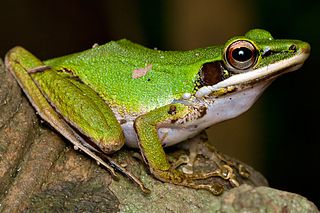
Chalcorana is a genus of frogs in the family Ranidae, "true frogs". They are found in Southeast Asia, from Thailand to Malay Peninsula and the Sunda Islands.
Papurana attigua is a species of frog in the family Ranidae, the "true frogs". It is found in central and south Vietnam, eastern Cambodia, and southern Laos. The specific name attigua is derived from Latin attiguus meaning "neighbor". It refers to the similarity of this species to Indosylvirana milleti. The common name similar frog has been coined for this species.
Chalcorana chalconota is a species of "true frog", family Ranidae. It is endemic to Indonesia and occurs in southern Sumatra, Java, Bali, and a few smaller islands. Populations previously assigned to this species now belong to a number of other Chalcorana species, leading to the current delineation of Chalcorana chalconota with a much narrower range. This species is also known as the Schlegel's frog, brown stream frog, copper-cheeked frog, or, among with many other species, white-lipped frog.

Chalcorana eschatia is a species of "true frog" in the family Ranidae. It is known from southern Thailand, but is likely to be more widespread. It was split off from Chalcorana chalconota by Robert Inger and colleagues in 2009, along with a number of other species in so-called "Rana chalconota group". The specific name eschatia, derived from the Greek word for "outskirt", refers to distribution of this species being at the edge of the geographical range of the group.
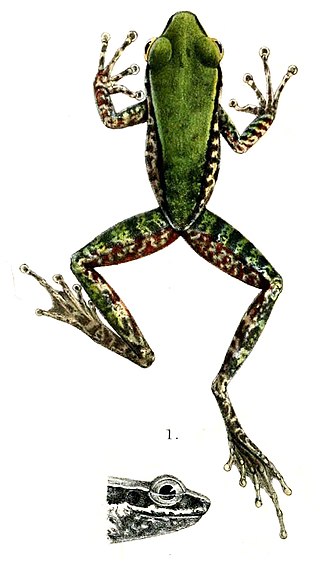
Chalcorana macrops is a species of "true frog" in the family Ranidae. It is endemic to Sulawesi, Indonesia. Common name Masarang frog has been coined for it. The specific name macrops refers to the large eyes of this frog.

Chalcorana megalonesa is a species of true frog in the family Ranidae, the "true frogs". It is endemic to Borneo and is known from both Malaysia and Indonesia (Kalimantan). It was split off from Rana chalconota in 2009 by Robert Inger and colleagues, along with a number of other species. Common name large white-lipped frog has been coined for it.
Chalcorana parvaccola is a species of "true frog" in the family Ranidae. It is endemic to Sumatra, Indonesia. It was split off from Chalcorana chalconota by Robert Inger and colleagues in 2009, along with a number of other species. The specific name parvaccola is derived from Latin parvus meaning small and accola meaning neighbor, and refers to this species being smaller than its "neighbor", the related Sumatran species Chalcorana rufipes.

Chalcorana raniceps, also known as the copper-cheeked frog, white-lipped frog, or Peters' Malaysian frog, is a species of "true frog" in the family Ranidae. It is endemic to Borneo, including Brunei Darussalam, Kalimantan (Indonesia), and Sarawak (Malaysia), although it is likely to occur more widely. Previously mixed with Chalcorana chalconota and believed to have much wider distribution, its range was delimited to Borneo in the revision of "Rana chalconota" complex by Robert Inger and colleagues in 2009.











